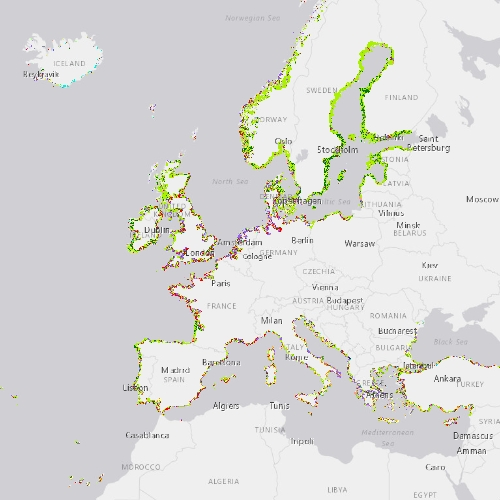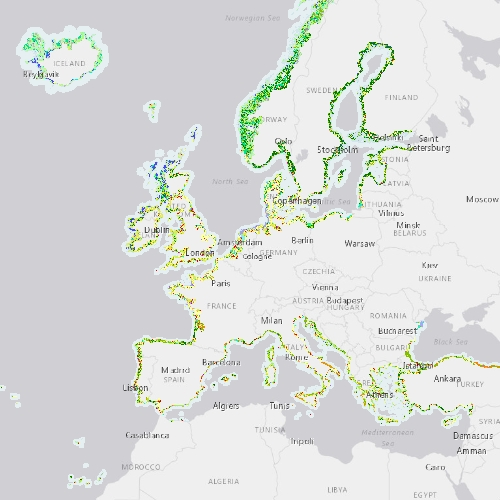10 m
Type of resources
Available actions
Topics
Keywords
Contact for the resource
Provided by
Years
Formats
Representation types
Update frequencies
status
Scale
Resolution
-

The Coastal Zones (CZ) LC/LU product for 2018 is providing a detailed Land Cover / Land Use (LC/ LU) dataset for areas along the coastline of the EEA38 countries and the United Kingdom, with reference year 2018 for the classification. This product monitors landscape dynamics in European coastal territory to an inland depth of 10 km with a total area of approximately 730,000 km², with all the relevant areas (estuaries, coastal lowlands, nature reserves). The production of the coastal zone layers was coordinated by the European Environment Agency (EEA) in the frame of the EU Copernicus programme, as part of the Copernicus Land Monitoring Service (CLMS) Local Component. The Coastal Zones product covers a buffer zone of coastline derived from EU-Hydro v1.1. Land Cover/Land Use (LC/LU) layer is extracted from Very High Resolution (VHR) satellite data and other available data. The class definitions follow the pre-defined nomenclature on the basis of Mapping and Assessment of Ecosystems and their Services (MAES) typology of ecosystems (Level 1 to Level 4) and CORINE Land Cover adapted to the specific characteristics of coastal zones. The classification provides 71 distinct thematic classes with a Minimum Mapping Unit (MMU) of 0.5 ha and a Minimum Mapping Width (MMW) of 10 m. The product is available for the 2012 and 2018 reference year including change mapping. This CZ dataset is distributed in vector format, in a single OGC GeoPackage SQLite file covering the area of interest.
-

The Coastal Zones LC/LU Change (CZC) 2012-2018 is providing the Land Cover / Land Use (LC/ LU) change for areas along the coastline of the EEA38 countries and the United Kingdom, between the reference years 2012 and 2018. The Coastal Zones product monitors landscape dynamics in European coastal territory to an inland depth of 10 km with a total area of approximately 730,000 km², with all the relevant areas (estuaries, coastal lowlands, nature reserves). The production of the coastal zone layers was coordinated by the European Environment Agency (EEA) in the frame of the EU Copernicus programme, as part of the Copernicus Land Monitoring Service (CLMS) Local Component. The Coastal Zones Change product covers a buffer zone of coastline derived from EU-Hydro v1.1. The Land Cover/Land Use (LC/LU) Change layer is extracted from Very High Resolution (VHR) satellite data and other available data. The reference years for the change are 2012 and 2018. The class definitions follow the pre-defined nomenclature on the basis of Mapping and Assessment of Ecosystems and their Services (MAES) typology of ecosystems (Level 1 to Level 4) and CORINE Land Cover adapted to the specific characteristics of coastal zones. The classification provides 71 distinct thematic classes with a Minimum Mapping Unit (MMU) of 0.5 ha and a Minimum Mapping Width (MMW) of 10 m. The status product is available for the 2012 and 2018 reference years. This CZC dataset is distributed in vector format, in a single OGC GeoPackage file covering the area of interest.
-

The Coastal Zones (CZ) LC/LU product for 2012 is providing a detailed Land Cover / Land Use (LC/ LU) dataset for areas along the coastline of the EEA38 countries and the United Kingdom, with reference year 2012 for the classification. This product monitors landscape dynamics in European coastal territory to an inland depth of 10 km with a total area of approximately 730,000 km², with all the relevant areas (estuaries, coastal lowlands, nature reserves). The production of the coastal zone layers was coordinated by the European Environment Agency (EEA) in the frame of the EU Copernicus programme, as part of the Copernicus Land Monitoring Service (CLMS) Local Component. The Coastal Zones product covers a buffer zone of coastline derived from EU-Hydro v1.1. Land Cover/Land Use (LC/LU) layer is extracted from Very High Resolution (VHR) satellite data and other available data. The class definitions follow the pre-defined nomenclature on the basis of Mapping and Assessment of Ecosystems and their Services (MAES) typology of ecosystems (Level 1 to Level 4) and CORINE Land Cover adapted to the specific characteristics of coastal zones. The classification provides 71 distinct thematic classes with a Minimum Mapping Unit (MMU) of 0.5 ha and a Minimum Mapping Width (MMW) of 10 m. The product is available for the 2012 and 2018 reference year including change mapping. This CZ dataset is distributed in vector format, in a single OGC GeoPackage SQLite file covering the area of interest.
-

Contours des réserves biologiques existantes (créées par arrêté ministériel) ou des projets ayant reçu l'avis favorable du CNPN (Conseil national pour la protection de la nature) mais encore en attente de leur arrêté de création. (diffusion publique) Dans les réserves biologiques intégrales (RBI), toute intervention humaine susceptible de modifier le milieu est proscrite : l'objectif de ces réserves est l'étude de l'évolution naturelle de l'écosystème. Dans les réserves biologiques dirigées (RBD), la gestion est orientée vers un objectif de protection d'espèces ou de milieux à haute valeur patrimoniale.
-

Base de données vecteur 2D couvrant l'ensemble du territoire métropolitain et les DOM. Il fournit l'information géométrique propre aux Ilots Regroupés pour l'Information Statistique. L'IRIS est la brique de base en matière de diffusion de données locales. Version 2 - Date de Publication : 2009
-

Collèges publics des Pyrénées-Atlantiques.
-

Position géographique des points de mesure du service des réseaux "Pluviaux" de la Communauté d'Agglomération de La Rochelle au débouché en mer des pluviaux primaires et indicateurs de qualité établis à partir des mesures de 2005 à 2008
-
Réseau routier départemental de la Charente. Il contient les différents tronçons d'axes représentant les routes (donnée linéaire). Un axe est une succession darcs ordonnés par rapport à ladressage linéaire. Cest une route revêtue (pour les réseaux routiers). Pour grand nombre d'entres eux, ils sont issus de la BDTOPO de l'IGN. En revanche ces attributs issus de la BDTOPO et concernant de nouveaux tronçons modifiés ou créés ne sont pas renseignés. Leur dénomination sera "Dx", "x" étant une donnée numérique de 1 à 1000. La voie gauche sera quant à elle nommée post-fixée "_G". ex : "D1_G". Principe de numérotation des bretelles seront dénommées : - D1_BR1_S correspond à la première bretelle sortante de la D1 ; - D1_BR1_E correspond à la première bretelle entrante de la D1 ; - D1_BR1 correspond à une bretelle intégrée dans un giratoire ; - D71_E1, D948_E1 ou D948_E2 correspondent à des nominations de bretelles entrantes ou sortantes antérieurement au SIGR. La numérotation des giratoires sera du type DXXXX_GIR_1 à 99. Les routes gérées par le département limitrophe reprendront la dénomination attribuée par celui-ci avec comme préfixe le numéro le dit département (ex 86DXXXX).
-

A compter de la rentée scolaire de septembre 2012, les élèves entrant au collège sont affectés à un établissement en fonction de leur adresse de résidence personnelle (et non en fonction de leur école primaire d'origine, comme auparavant). Cette couche décrit le secteur de recrutement des élèves pour chacun des 48 établissements. NB 1 : certains de ces établissements prennent en charge des élèves résidant dans des département limitrophes, et à l'inverse, certaines communes sont affectées à des établissement hors Pyrénées-Atlantiques. NB 2 : 8 communes font l'objet d'un découpage infra-communal, et donc couvertes par plusieurs établissements différents. Couche élaborée à partir de la BD Topo et BD Adresse IGN du RGE 2011 ©
-
Cartes de végétations du CNES sur le territoire départemental des Pyrénées-Atlantiques datant de 1969, 1970 et 1976
 Catalogue PIGMA
Catalogue PIGMA